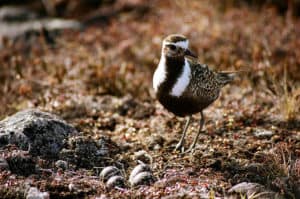Share this article
Half of Arctic shorebirds are declining; waterfowl flourish
Across the circumpolar north, some Arctic tundra birds, such as waterfowl, seem to be flourishing while others, like most shorebirds, are seeing their populations fall, according to new research spanning multiple nations.
“We’ve known for a long time that lots of bird species are declining,” said Paul Smith, a research scientist with Environment and Climate Change Canada and the lead author of a study published recently in Ambio.
But getting a better grasp on these numbers has been difficult since many of these birds spend their summers in remote parts of the Arctic and disperse widely across the globe during the Arctic winter.
While the study didn’t look into the reasons for these declines, Smith said that loss and degradation of the coastal habitats used during migration and winter might play a role.
He and his colleagues, which include more than a dozen bird researchers from countries across the circumpolar north, pooled studies and data available in their respective countries to better understand how tundra birds were doing throughout the world.

An American golden plover (Pluvialis dominica). ©Jennie Rausch
They looked at 88 species and 228 subspecies or birds including populations with distinct migratory flyways, comparing numbers from the 1970s, or as far back as possible, to the present day. They used the data from both published and unpublished studies as well as bird-banding data and other sources of information available in Arctic countries.
Their findings were striking — different types of birds faced different outcomes. Shorebird species seemed to have been hit the hardest, with 51% of the known 91 of the 91 populations for which trends could be estimated in decline, including birds like plovers and sandpipers.
“In the Arctic, they are one of the most diverse groups of birds,” Smith said.
The rufa subspecies of Red Knots (Calidris canutus rufa), famous for lengthy migrations from northern Canada to as far south as Argentina, have declined by about 80% in North America. Semipalmated plovers (Charadrius semipalmatus), another North American species, have declined. Red knots are facing the loss of their main prey species, Atlantic horseshoe crabs (Limulus polyphemus), in a key migration stopover in Delaware Bay. Climate change can affect the amount and timing of snow cover, large scale patterns in winds, and the frequency and severity of storms; these factors can impact rufa Red Knots as they travel thousands of kilometers from the southern hemisphere to the Canadian Arctic and back each year.
Conversely, waterfowl appeared to be doing well, with 49% of the 61 species or populations examined increasing.
“They’re doing so well that some species have exceeded their population targets,” Smith said, citing the examples of Snow Geese (Chen caerulescens) expanding their range in North America, and pink-footed and barnacle geese (Anser brachyrhynchus and Branta leucopsis) expanding their ranges in Europe.
The researchers also found regional differences between species. They found tundra birds were doing best in the African-Eurasian flyway compared to other regions in the world. Smith credits this success to conservation programs in Europe.
North American flyway birds are doing better than Asian flyway birds, partly due to unregulated harvest in Asia.
Header Image: A Baird’s sandpiper (Calidris bairdii). Some tundra shorebirds that spend their summers in the Arctic are experience population declines. ©Paul Smith








